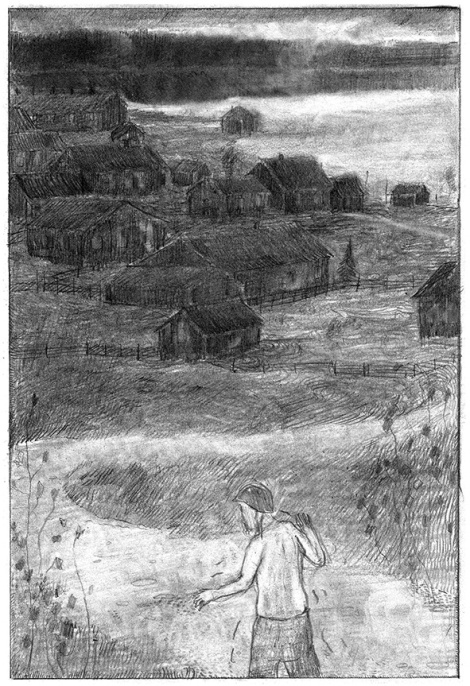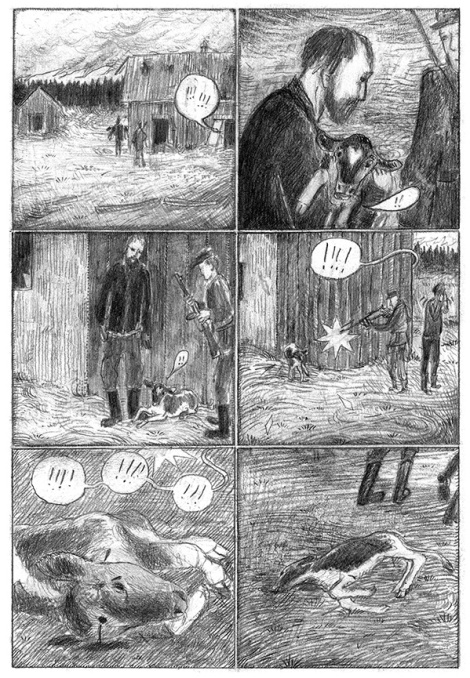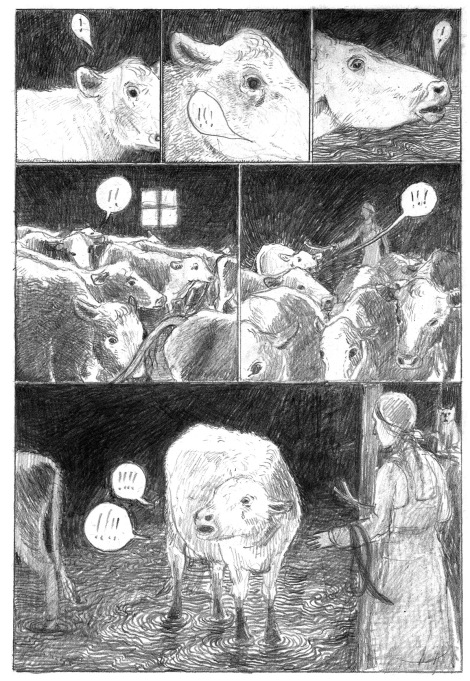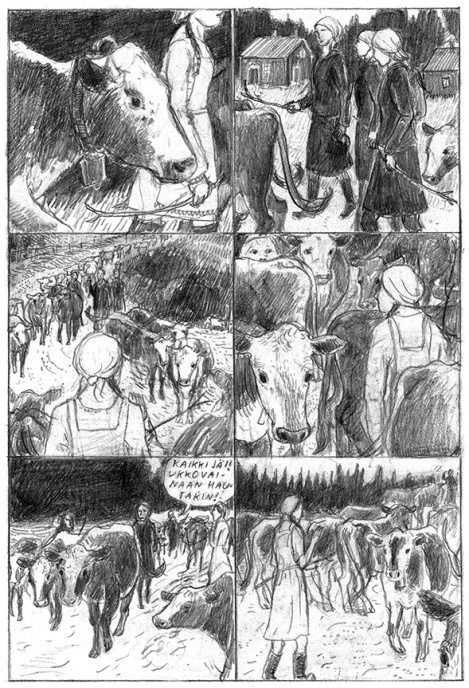A conversation with comic artist Hanneriina Moisseinen, written by Saskia Gullstrand. Part 1.

Page from Kannas / The Isthmus by Hanneriina Moisseinen
I have just read the comic book Kannas / The Isthmus, written and drawn by Hanneriina Moisseinen. This scene replays in my mind:
There’s a man stumbling through a burned forest. His face is like a mask of death, a skull barely covered with dry skin.
He’s wearing soldier’s trousers; he used to be a soldier. Ghosts emerge from the ground around him. The man has walked into a woodland cemetery: the crosses all bear the same name: UNKNOWN, UNKNOWN, UNKNOWN. A runaway cow walks up to him; licks his hands. Her udder is dripping with milk, flowing over. He milks her, using a combat helmet as his bowl. He puts the helmet on and milk flows down his body. Then he stumbles on, further into the forest.
Kannas / The Isthmus tells the unspoken stories of women, animals and deserters on the frontline of the Second World War battles between Finland and the Soviet Union. In English, a “kannas”, or “isthmus” can be translated as “a narrow strip of land, bordered on both sides by water, connecting two larger bodies of land”. The title refers to the Karelian isthmus that belonged to Finland before the war, but is part of Russia today. During the war, this land was crossed by a number of military defensive lines, with the fronts moving back and forth over it.
A book about cows and war. What can it show us? In September 2016, Hanneriina and I met up in Helsinki, to talk about memory work, embroidered pages and photographs, and what war does to people.
YOU WERE NOT SUPPOSED TO TALK ABOUT THE DESERTERS AND THOSE WHO LOST THEIR MINDS.
Saskia: Could you read the text here on the back of the book aloud for me?
Hanneriina: It says: “We had to leave absolutely everything” in Karelian dialect. That’s all I wanted for the back.
S: How different is this dialect from ordinary Finnish?
H: People can recognize that it’s from the south of Karelia. The phrase is also something that people would connect with the area that was lost after the war.
S: If you were to introduce yourself to someone who doesn’t know who you are, as a person and a comic artist, what would you say to them?
H: I would probably say my name, that I’m a graphic novel artist and that usually my graphic novels are serious ones. I put a lot of effort to both the story and the pictures. I’m interested in taboos and topics that are rare, things that people don’t like to talk about.
S: In what way have you been working with taboos in Kannas, your most recent book?
H: There’s this character, Auvo Oksala…
S: The shell-shocked man.
H: He’s a deserter. He has survived an attack from a Red Army tank; all the other soldiers in his unit are dead. Other men come to search for anybody who was still alive. They found Auvo under a pile of dead bodies; he had lost his mind. So far, this has been a taboo in Finnish war literature. There’s this researcher, Ville Kivimäki, who recently made a book called Murtuneet mielet that could be translated as ”Broken Minds”. It’s the first major book that deals with the topic of soldiers going crazy on the front. He says in his research that it’s possible to read nine thousand pages of Finnish war literature, without once reading a full description of someone who went crazy in the war. He says it’s because Finnish war literature has often followed the ideas of Finnish war propaganda. So you weren’t supposed to talk about the deserters and those who lost their minds.
S: How many of the soldiers and their close relatives do you think have had those hidden, traumatic experiences?
H: Many. The whole nation was basically mobilized for the war, even teenage girls and boys, who volunteered. Some youngsters were sent to different places to do work for the war, such as putting the bodies of the dead soldiers to the coffins. Most of the people lost someone during the war. It was a huge loss of people. I don’t remember the percentage, but a big part of the population died or was injured, mentally and physically.
S: Could you give a short recap of the Second World War from a Finnish perspective? When did it start and when did it end for Finland?
H: From 1939 to 1940, there was the Winter War. Then there was a break of a year or so, then the war started again in 1941. The Continuation War lasted until 1944.
S: Kannas is about the border land of Karelia, divided between Finland and Russia, and the border that shifted during the war, as the countries took from and lost land to each other. What happened to the people in the Karelian villages? What was the war like for them and what was it like when the war ended?
H: They were evacuated during the winter war. Almost everybody wanted to return home: they thought “we will just continue living here”. Finland took back the areas from the Soviets, and even went further to take places that hadn’t been Finland before, for example, Petrozavodsk, which is quite far actually. There was a fascist idea of Suur-Suomi, Great Finland. The most of the inhabitants moved back to Karelia. In some places, entire villages were burned, only the chimneys and ovens remained of the houses. They wanted to make bread, so they went to the only working oven in the village to bake it. It was just a bare oven, with no house around it. First some people dug themselves a home in the ground, made roofs and lived there while they rebuilt their houses. First the sauna, of course. Then they just continued living there. In summer 1944, the last people had finished their new houses. Everything was new and they were just ready to start again. Most of the people lived in the countryside, so the fields where prepared, the hay was growing and waiting for the harvest. That’s when the peace came. The Soviet Union demanded these areas. The Red Army came again, towns and villages were bombed and burnt, and everyone had to leave once more.
THE ROAD OF THE EVACUEES

Page from Kannas / The Isthmus by Hanneriina Moisseinen
S: There’s a scene quite early in this book, where we meet the other main characters of the book; a young woman named Maria and her cows. They live in a small Karelian village. One of the cows is giving birth, but they have to be evacuated because the Soviet army is coming. The people want to take the cows with them, but they cannot take the baby calf, because it’s too young, so they have to kill it. When I read that, I was really struck by the realization that this cow must have been pregnant for months, and the people just let her become pregnant as usual. They didn’t expect at that time, that this young animal wouldn’t be able to live its normal life on their farm.
H: Women also gave birth on the way. The evacuated people where packed onto cargo wagons, together with their farm animals. In every wagon there was about 40 people, and probably some animals. There were women who gave birth there. They didn’t even have water. People couldn’t wash their hands.
S: Or the babies.
H: I’ve heard of a woman who gave birth to twins [laughs]. That’s like too much! But they survived.
S: How was the evacuation process organized? Was it army people who came to the area the day before and said: “It’s your turn to go”, or was there a plan long before?
H: Sometimes it was soldiers who came to the villages, and sometimes they named somebody to be responsible for the evacuation of the whole village. Sometimes people were warned two days in advance. They were told that on this day, you have to gather at this spot; you can take as much as you can carry yourself with you, like a little backpack. They were given information, and along the roads there were signs showing that this is the way for the evacuees. But sometimes, the last warning to leave came all of a sudden, like, “you have to leave in two minutes”, as in this book. I read some memoirs from evacuated people. A mother of a family was waiting for the peace to come. Then there was an announcement on the radio that peace was finally there. She was so relieved, after waiting for such a long time. Then, the radio speaker continued: “Here are the conditions of the peace from the Soviet Union: Finland shall give up these areas to the Soviet Union”. It was exactly where they lived.
S: Did anyone stay after their homeland was given to the Soviet Union?
H: Very few. Some old people didn’t want to leave at all. There’s a story of a grandmother who was waiting on the train station for the evacuation train. Bomb planes attacked the train station, and she was like [in the hissing voice of an elderly woman]: “Come on, come on, bomb me! I don’t want to leave Karelia, I want to die at home!”
S: There are stories of elderly women like that from so many places. Quite recently, a documentary was released about the elderly women who still live in the Chernobyl region. They are alive, living their lives as they used to before the catastrophe in the 1980s. When the nuclear power station meltdown happened, everybody was eventually forced to leave by the state. But these women just refused to move, and they must have been so determined to stay, to not be moved by the government. Why do you think elderly women and elderly people in general refuse to give up the place where they have lived for so long, even when their own survival is at stake?
H: The place is everything they know. They belong there. It’s their life. Apart from the elderly people, cats and dogs were left behind in Karelia. They don’t know about the “fatherland”; they have their place in the villages. So they remained there. Sometimes people found their cats and dogs when they returned after the winter war. A few people stayed, but most of them were taken to western Finland during peacetime. Some Finnish people had sympathies for the Soviet Communist Party, so they crossed the border illegally and started a new life in the Soviet Union. Maybe with a new identity.
FEEL THE PAIN IN THEIR OWN BODIES

Page from Kannas / The Isthmus by Hanneriina Moisseinen
S: This book is also a book about animals, and how animals experienced the war. Why did you want to show that?
H: Because I’m so bored with the heroic war stories told by men. I think that some people nowadays have difficulty understanding the war. There are specific, very common ways of talking about the war, and I’m very bored with those patriotic narratives, marching music and so on. Also, thinking of films or other entertainment… if there are scenes where people are hurt or killed, the audience doesn’t feel anything. But people react very strongly to when animals are killed or tortured. They even call the production company and say, “Hey, why was this animal tortured in the film?” People can connect emotionally to the animals much better. They somehow see their innocent side. That’s why I choose animals, because people really feel their physical pain with their own bodies, even more than when they see another human suffer.
S: In the comic, you took the opportunity to show the animals’ perspective. On one page, you’ve drawn it so that the readers goes into the mind of a cow, everything you see is through this cow’s eyes.
H: It’s kind of the sight of the cow.
[Hanneriina opens the comic at this double-page spread.]
H: I can not know how you experience the world when you belong to other species than human, but it’s interesting to think how the world would appear as a non-human. On the first page is the close up of the cow’s eye, and in the next panel she sees the young woman Maria, who is the other main character of the book. The round shape of the eye repeats here [shows in the book], framing the following panels. I made it like this, even though I found out that eyesight is very different for cows compared to people. People can see between 180 degrees and 110 degrees, but the cow can see 300 degrees to 60 degrees, so their sight is very narrow and very wide.
S: Like when you take a panorama picture? That’s really interesting! But it would have been a bit weird if it was shown like that in your comic.
H: That’s what I thought. So I repeated just the round form of the eye.
S: It works very well. Once, I heard on the radio the number of animals that are killed in traffic every year in Sweden. It’s an insane amount of animals, like 200 000 rabbits and so on, and that’s just a normal year of traffic in Sweden. When it comes to war, we usually only talk about people, not about how plants, animals and ecosystems are affected, being killed in bombings or by having their habitat destroyed, or being burned or shot. Did you also feel that there was a point of reminding people of this side of war via this book?
H: Yes. I put this photograph of Kollaa, an area that was really badly damaged during the war. The trees are like skeletons, almost. You can see here that it used to be a forest, but now it’s just ruins.
[Hanneriina shows a photograph in the book, one of many that she has included in the comic]
A LONG SERIES OF PHOTOGRAPHS
S: Speaking of the photographs you have included in the book; are these modern images, or from the war?
H: These are from archives. All the photographs in the book were taken by Finnish soldiers during the war.
S: You said before that there’s this narrative that keeps repeating about what the war was like. I feel that it’s the same with as the kind of photographs that are selected to represent this time; it’s always the same photographs, of men in uniforms… But in your book, there are so many photographs that I felt that I’ve never seen before. Like this, for example, with the tank firing in the forest [shows this page to Hanneriina]. Some of these images are almost surreal. I can’t imagine how they was taken. Who photographed this? What do you know about this image?
H: I don’t remember exactly. It might be from a real situation, but it might also be from a practice, when they were practising shooting the tank and the photograph was taken. For me, what was interesting with this image, is also what relates it to Auvo. In Finnish, the term for shell-shocked is ”tärähtänyt”, which means that there’s some kind of explosion, and when for example a soldier experiences that closely, in a traumatic way, the tremor, in Finnish “tärinä”, continues in his body so that his body continues trembling a very long time after the explosion. This photograph looks similar to that; it’s rippled, almost like a soundwave is moving through it. In the comic, this picture represents the moment when Auvo gets shell-shocked. The soldiers who became shell-shocked were shaking all the time, and I repeated this movement in his hands that are continually shaking. He’s also repeating some of his words, like somebody who is traumatized.
S: He says at one point that he has lost his head. After that comes a photograph of a naked dead man being carried into a casket by other soldiers. At the first glance, it looks like his head is missing. But then I saw that his head was thrown backwards. What was your work process using the photographs and the drawings in this story? Did you start to make a storyboard of your comic, and then you choose the photos that you wanted to include, or how did you do it? Because it works so seamlessly. As a reader, I’m never thrown out of the suspension of disbelief, I’m always just pulled in deeper into the story.
H: I had the original photos on my studio walls when I drew the comic. Then I printed pages of archive photographs, and tested which ones would work and where. In the final section, I didn’t want to draw the journey of the evacuees, instead I wanted to put a long section of photographs of people walking with their cows, animals and sofas. There are some photographs of runaway cows wit soldiers who look like they are interviewing the cows or something, which I think is funny.
S: Like cow deserters.
[Hanneriina shows me image after image.]
H: Some photos of milking a runaway cow. Here’s a dead horse. Some children sleeping. A young boy with sheep. A woman with some cows. An elderly couple with a religious icon. A woman who’s lost everything. Another woman who’s lost everything. More women who’ve lost everything. Then someone who’s taking water from a well that has survived among the ruins. I wanted a very long series of photographs and I worked with them until the very, very end.
OTHER TRUTHS ABOUT THE WAR
S: Tell me more about Maria, your other main character apart from Auvo. Is she based on a specific person or is she a fictional character that draws on many people?
H: I composed her character. There was one lady writing her memoirs from the war, and she had written them very well. Her writing kind of inspired me to have this young female character in the book. But she’s totally fictional.
S: How did you work in the archives? What was the start of the project; how much did you study before you began to draw?
H: The beginning was Anne-Mari Kivimäki’s Ph.D. thesis for the folk music department of the Sibelius academy in Helsinki. She asked me to do comics about Karelian accordion music since this almost doesn’t exist in the Finnish music history. Back in those days, the Finnish authorities preferred Karelian kantele music. [A kantele is traditional Finnish and Karelian plucked string instrument, a type of box zither]. They thought Karelian accordion music was somehow similar to Soviet music and they didn’t like that. But the local people for example liked to dance to the accordion music more than to the kantele music. Anne-Mari asked me to do a comics exhibition where she could come and play concerts. So I went to the archives, and I started to do research. I just spent a long time there, trying to find an angle that I could use. Then I found texts on how women had to walk with their cows from Karelia to western Finland during the war. This interested me. I started to read the stories from the evacuated people, and began to search for stories that where related to animals. Then it started to build up.
S: Are there more connections between her Ph.D. thesis and this book, apart from her making music and performances in the exhibition version of Kannas?
H: In her research, Anne-Mari has proven that before the wars the accordion music was more popular in Karelia than the kantele music, but also that the Karelian musicians played the kantele songs with an accordion and vice versa, which makes the Karelian accordeon music quite unique. In Kannas, I also wanted to tell some truths that hadn’t been told before. I took the topic of cows, of having the cowgirl and the shell-shocked deserter as my main characters for this war story. I wanted to show that there are other truths about the war, not just the official one.
S: In Kannas, we focus only on these truths, and not on the heroic ones.
H: I think there are no heroes in this book. Well, maybe Maria. But the ending also shows that she has lost her mind as well, or at least has got an illness that affects her memory. She is old by then, living in an apartment in modern day Helsinki. I don’t want to say too much about this, I’d rather prefer that you read it yourself. But what I can say is that for the last image in the book, I knew I wanted a photograph of a woman that would be like Maria. Here in the end of the book is the girl with the cows, and in the last image, she’s kind of going home. She’s calling the cows to come home.

.
HANNERIINA MOISSEINEN was born in Joensuu, Finland in 1978. She has an artistic background in fine arts, especially drawing, sculpting and installation, but she has been drawing comics since the 1990s. In her work, she often mixes delicate, detailed drawings with other media, like embroidery or archive photography. She has an MA degree from the Aalto University.
Her stories are about themes that are considered taboo, like sexual shame, family secrets and the non-heroic sides of war. In 2013, she published her autobiographical comic Isä / Father that tells the story of how the father of a family disappears with no reason, and is never found again.
Kannas / The Isthmus is her most recent book. It tells the Finnish history of World War Two from the perspective of cows, women and a shell-shocked deserter. The book brought her the Finnish state prize for comic art.
SASKIA GULLSTRAND is the art director and founder of Underlandet Comics Art Lab. In September 2016, she travelled to the Helsinki Comics Festival to interview the Finnish comic artists Hanneriina Moisseinen, Katja Tukiainen, Hanna-Pirita Lehkonen, Taina Hakala, Johanna Rojola, Tommi Musturi and Amanda Vähämäki. The interviews are part of Underlandet’s ambition to create and share conversations between comic artists.
